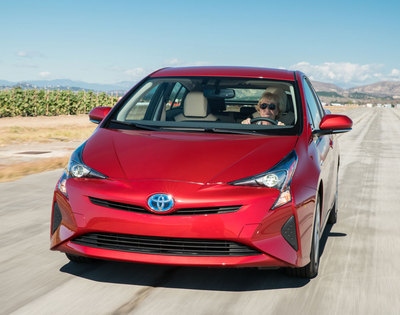First DRIVE : 2016 Toyota Prius Review By Henny Hemmes
Adding the ‘Wow! Factor
By Henny Hemmes
Senior European Editor
November 18, 2015.
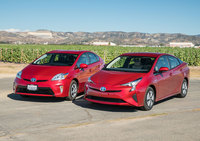 |
After the Prius went on sale in Japan in 1997, Toyota waited three years before offering its first hybrid in countries world wide. It marked the start of hybridization of the automotive industry and has proven to be a clever decision is proven, since more than 3.5 million units have been sold globally.
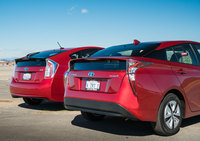 |
The Prius is a popular hybrid car, also in The Netherlands, partly thanks to government incentives for lease and other businesses. With the new generation, Toyota hopes to attract more customers with different requirements. People who up till now were not necessarily interested in wheels, or a car with a hybrid driveline, but who are looking for one with dynamic handling and good fuel economy. The 2016 Prius may just fit in this frame… believe me!
Sleeker
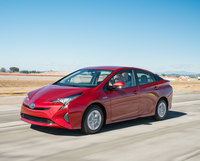 |
The base Prius will be equipped with a nickel-hydride metal battery, but all other variants will get the 30 pounds lighter (but more expensive) lithium-ion battery. However, both batteries offer the same performance and fuel economy. Thanks to the smaller, flatter shape they fit under the rear seat, instead of in the luggage compartment like in the outgoing model.
The new Prius is equipped with the updated 1.8-liter 4-cylinder engine has a 40 per cent improved thermal efficiency, which helps decrease fuel consumption. The latter is expected to be 52 mpg (final EPA figures pending), which is the same as of the current model’s use of regular gasoline. Toyota expects the new Eco model to rate at 56 mpg thanks to a lower weight and optimized aerodynamics with a coefficient of drag of 0.24.
With 121 hp, the power of the new Prius is less powerful than of the outgoing model (134 hp). According to Toyota, this is the result of a different measuring system. As before, there are three modes, Eco, Normal and Power, that are reflected in the display, which also offers read outs for hybrid energy info and more. Drivers can choose how much information he or she wants to see by selecting a simple or segmented display set up.
Impressive
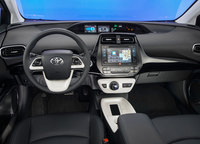 |
All we need to drive the car and use its features are located in a logical spot, including the new electric fuel lid release.
It is time to head for the roads that lead to our utmost test. The steering is direct and offers good feed back. The ride comfort is excellent and the suspension is well set to deal with different road surfaces and winding country roads, while offering good stability on the straight run. ‘Sure footed’ would be an appropriate term.
Adding to the comfortable feel is the quietness inside, which is a result of extra sound damping in the new model. The start-stop system works smoothly and the electronically controlled CVT transmission is working quieter and more linear than in models of some other manufacturers.
Then we reach the handling course, which Toyota had set out on El Toro, the former air force base near Irvine in Southern California.
Here, we are up for a real surprise. The pylons mark a slalom, soft and sharp bends and a long 180 degree turn. After the first lap I push the throttle, but the Prius does not give in easily. The turn in feel is excellent and there is hardly any under steer. The full-stop between the last two pylons is easy to dose and work really good. My co-driver and me are impressed.
When we take the Touring variant, available for both Grade Three and Four (Two is the base), we already know that the springs and shock dampers have a stiffer set up. We could hardly believe ourselves, but we both agreed that the new model offers good power and is quite fun to drive. Quite fun! Indeed, thanks to its dynamic handling. At El Toro we could drive the 2015 model for reference. It will not surprise you to learn the new models has is a huge improvement.
Extended safety systems
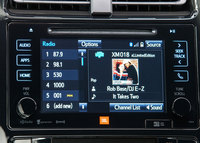 |
The Prius is also one of the first Toyotas to offer TSSP, Toyota Safety Sense Package with driver assist technologies that help avoid collisions and includes pre-collision with pedestrian detection, lane departure warning and assist, automatic high-beam and full-speed dynamic radar cruise control that works in stop and go traffic down to a full stop
Furthermore the car has standard bi-LED head light, which together with the rear lights and rear spoiler make the new model easy to distinguish from the outgoing one. The 2016 Prius will reach the market in mid February. Pricing starts at $24,200 (MSRP) for the Grade Two tot $ 30,000 for the Four Touring.
Technical details
Engine: 4-cylinder, DOHC, 1,797 cc, output 958 hp@5,200, max torque 105 lb-ft@4000 rpm.
Electric engine: output 72 pk/53 kW,
Length: 178.7 inches, width: 69.3 in., height: 58.1 in.,
Wheelbase: 106.3 inches
Base curb weight: 3,075 lbs. (3,010 Eco)
Performance: acceleration 0-62 mpg 10,4 s, top speed 112 mph.
Fuel consumption:: from 52 mpg
The Most In-Depth Toyota Vehicle Shopper's Research - Anywhere!



